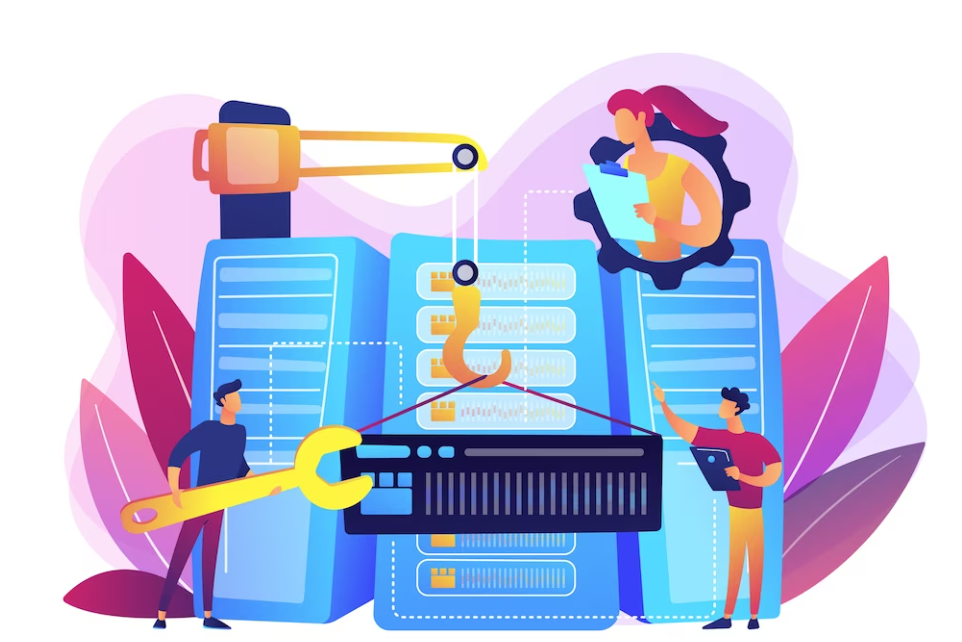Seamless System Integration for Legacy Systems | Stoke Apps
In today’s fast-paced business environment, companies are continuously looking for ways to enhance their operations while minimizing costs. One of the best ways to achieve this goal is by breathing new life into legacy systems by integrating them with modern technology. By doing so, businesses can streamline their operations, reduce operational costs, and increase revenue. In this article, we will explore how seamless system integration can help businesses maximize their ROI.
Introduction
Legacy systems refer to software applications, platforms, and technologies that are outdated and no longer meet the needs of modern businesses. These systems are often costly to maintain, require specialized skills to operate, and lack the flexibility and scalability required to keep up with the changing needs of businesses. However, many businesses still rely on these systems, as they are essential to their operations.
What is System Integration?
System integration refers to the process of combining different systems, applications, and technologies into a single cohesive system that can share data and work seamlessly together. This integration allows businesses to achieve a higher level of efficiency and automation, resulting in reduced operational costs and improved productivity.

Why Integrate Legacy Systems?
Integrating legacy systems with modern technology can bring numerous benefits to businesses. First and foremost, it can significantly reduce operational costs by automating processes that were previously done manually. This automation allows businesses to save time, money, and resources, while reducing the risk of errors and increasing accuracy.
Secondly, system integration can improve data visibility and accessibility. By integrating legacy systems with modern technology, businesses can access and analyze data from different sources in real-time. This real-time data analysis can help businesses make informed decisions faster, which can lead to increased revenue and improved customer satisfaction.
Lastly, system integration can improve overall business agility. By streamlining processes and automating tasks, businesses can respond to market changes faster, which is crucial in today’s fast-paced business environment. This agility allows businesses to stay ahead of the competition, resulting in increased revenue and market share.
How to Integrate Legacy Systems?
The process of integrating legacy systems can be complex and time-consuming. However, by following a structured approach, businesses can minimize the risks and ensure a seamless integration. The following are the steps involved in integrating legacy systems:
Step 1: Define Business Goals
The first step in integrating legacy systems is to define the business goals that the integration will help achieve. These goals could be improving efficiency, reducing operational costs, improving data accuracy, or enhancing customer satisfaction. Defining these goals will help businesses identify the systems that need to be integrated and prioritize the integration process.
Step 2: Assess Legacy Systems
The next step is to assess the legacy systems that need to be integrated. This assessment should identify the systems’ capabilities, limitations, and compatibility with modern technology. This assessment will help businesses determine whether the legacy systems need to be replaced, upgraded, or integrated with modern technology.
Step 3: Choose Integration Method
After assessing the legacy systems, the next step is to choose the integration method. There are various integration methods available, including application programming interface (API) integration, middleware integration, and custom integration. Each method has its pros and cons, and the choice of method will depend on the systems’ complexity, budget, and time constraints.
Step 4: Plan Integration
The next step is to plan the integration process. This planning should include identifying the integration team, defining roles and responsibilities, creating a project plan, and setting timelines and milestones. This planning will help businesses ensure a seamless integration and minimize the risks involved.
Step 5: Test and Deploy
As the development of an integrated system comes to a close, the final step is to test and deploy it. This critical phase involves meticulous testing of the system’s functionality, security, and performance. Robust testing ensures that the system is free of defects and operates optimally. Security testing is essential to ensure that the system is protected from potential threats and vulnerabilities. Performance testing assesses the system’s responsiveness, scalability, and resource utilization. Successful completion of testing and deployment is a crucial milestone, marking the readiness of the system for use.
Boost Efficiency and Crush the Competition with Digital Automation
Integration Methods
Once testing is complete and any issues have been resolved, the integrated system can be deployed. It is crucial to train employees on how to use the new integrated system to ensure a smooth transition.
There are several integration methods that businesses can use to integrate legacy systems with modern technology. Each integration method has its advantages and disadvantages, and businesses must choose the method that is best suited to their specific needs. Here are four common integration methods:
Point-to-Point Integration
Point-to-point integration is a direct connection between two systems. This integration method is simple and easy to implement, making it a popular choice for businesses with a small number of systems. However, point-to-point integration can become complex and difficult to manage as the number of systems increases. It also lacks flexibility and scalability, making it less suitable for businesses with complex integration needs.
Middleware Integration
This integration involves the use of middleware software to connect legacy systems with modern technology. Middleware acts as a bridge between systems, translating data from one system to another. This integration method is more flexible than point-to-point integration and allows for the integration of a large number of systems. However, middleware integration can be costly and complex to implement.
API Integration
API integration involves the use of Application Programming Interfaces (APIs) to connect legacy systems with modern technology. APIs allow systems to communicate with each other and share data. This integration method is flexible, scalable, and cost-effective. It is also easy to implement and maintain. However, API integration requires a certain level of technical expertise and may not be suitable for businesses with complex integration needs.
Service-Oriented Architecture (SOA)
SOA is an integration method that involves breaking down business processes into smaller services that can be integrated independently. This integration method is flexible, scalable, and allows for the reuse of services across different systems. However, SOA can be complex and difficult to implement, and requires a significant investment in infrastructure and expertise.

Skyrocket Your Business Growth with Cutting-Edge SaaS Development
Benefits of Seamless System Integration
Seamless system integration offers numerous benefits to businesses, including:
Improved Efficiency
Seamless system integration automates tasks that were previously done manually, resulting in improved efficiency and productivity. This automation reduces the time and resources required to complete tasks, allowing employees to focus on more important tasks.
Reduced Costs
Integrating legacy systems with modern technology can significantly reduce operational costs by automating tasks and streamlining processes. This automation reduces the risk of errors and increases accuracy, which reduces the costs associated with correcting errors.
Improved Data Visibility
System integration allows businesses to access and analyze data from different sources in real-time. This real-time data analysis enables businesses to make informed decisions faster, resulting in improved customer satisfaction and increased revenue.
Improved Business Agility
Seamless system integration streamlines processes and automates tasks, allowing businesses to respond to market changes faster. This agility enables businesses to stay ahead of the competition, resulting in increased revenue and market share.
Increased Security
Seamless system integration can improve overall system security by consolidating security controls and reducing vulnerabilities. This consolidation reduces the risk of security breaches and improves compliance with data protection regulations.
Challenges of Seamless System Integration
Seamless system integration can be a complex and challenging process, and businesses may face several challenges during the integration process. Here are some of the most common challenges that businesses may encounter:
Compatibility Issues
One of the primary challenges of seamless system integration is compatibility issues. Legacy systems may not be compatible with modern technology, making integration difficult. This can lead to data loss, errors, and security vulnerabilities. To address this challenge, businesses may need to upgrade their legacy systems or find workarounds to ensure compatibility.
Data Migration
It is another significant challenge that businesses may face during seamless system integration. Data migration involves moving data from legacy systems to modern technology. This can be a time-consuming process, and there is a risk of data loss or corruption. To address this challenge, businesses must carefully plan data migration and ensure data integrity.
Cost
Integrating legacy systems with modern technology can be expensive, as it requires specialized skills, tools, and software. The cost of integration must be balanced against the potential benefits to ensure a positive ROI. To address this challenge, businesses must carefully assess the cost of integration and prioritize business goals.
Resistance to Change
Resistance to change is a common challenge that businesses may face during seamless system integration. Employees may be resistant to changes in their workflow or may lack the necessary skills to use the new integrated system. To address this challenge, businesses must communicate the benefits of the new system, provide training to employees, and involve employees in the integration process.
Time Constraints
Seamless system integration can be a time-consuming process, and businesses may face time constraints. Delays in the integration process can impact business operations and revenue. To address this challenge, businesses must carefully plan the integration process and ensure that all stakeholders are aware of the timeline.
Overcoming the Challenges of Seamless System Integration
To overcome the challenges of seamless system integration, businesses can follow a structured approach that includes the following steps:
Define Business Goals
Businesses must define clear business goals and objectives for seamless system integration. This includes identifying the key benefits of integration, such as increased efficiency, reduced costs, and improved data visibility.
Assess Legacy Systems
Businesses must assess their legacy systems to determine their compatibility with modern technology. This includes identifying any gaps or vulnerabilities that may impact the integration process.
Choose an Integration Method
Businesses must choose an integration method that is suitable for their specific needs. This includes deciding whether to use a point-to-point integration or an integration platform.
Plan Integration
Businesses must carefully plan the integration process to ensure that it is executed smoothly. This includes defining the scope of the integration, identifying dependencies, and developing a project plan.
Test and Deploy
Businesses must thoroughly test the integrated system to ensure that it meets their requirements. This includes testing for data accuracy, performance, and security. Once testing is complete and any issues have been resolved, the integrated system can be deployed. It is crucial to train employees on how to use the new integrated system to ensure a smooth transition.
By following a structured approach and prioritizing business goals, businesses can successfully integrate legacy systems with modern technology and reap the benefits of seamless system integration.
Conclusion
Seamless system integration can breathe new life into legacy systems, improving efficiency, reducing costs, and increasing revenue. However, Businesses must be prepared to face challenges such as compatibility issues, data migration, and cost. By following a structured approach and prioritizing business goals, businesses can successfully integrate legacy systems with modern technology and reap the benefits of seamless system integration.
If you’re struggling with legacy system integration, don’t hesitate to take action. Evaluate your integration needs, explore different integration methods, and contact us with our experts in the field to find the best solution for your business. With the right integration strategy in place, you can breathe new life into your legacy systems and unlock their full potential.
